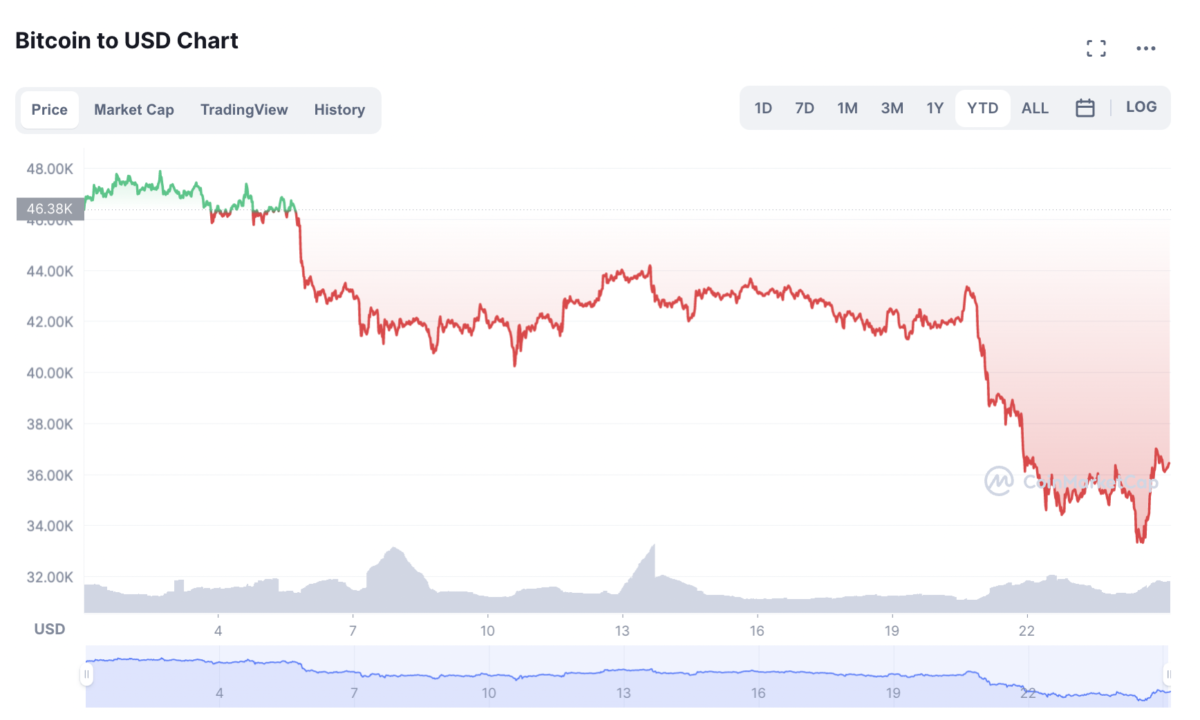
Crypto investors and blockchain enthusiasts haven’t exactly enjoyed a fantastic start to 2022. Excluding stablecoins, every single one of the top 100 cryptocurrencies by market cap are firmly planted in the red year-to-date (YTD).

General sentiment and price action in the crypto market have been steadily moving from bad to worse for a while now, with a broad downturn persisting from mid-November last year.
On November 10, Ethereum (ETH) hit a new all time high of US$4,878 (AU$6,693) and just 2 days later on November 12, Bitcoin (BTC) also reached a new all time high of US$69,044 (AU$93,482). Facebook had just transformed itself into Meta, NFTs were selling for the price of superyachts and the world seemed ready to embrace the new era of digital assets, decentralisation and the strangle lands of the metaverse.
For many crypto pundits, this recent downturn seemed to be directly at odds with both the financial and technological developments in the world of cryptocurrency. Understandably, plenty of investors have been left scratching their heads, and trying to shake off the repeated wincing that comes with the compulsive checking of a crypto wallet that keeps sliding deeper into the red.
What’s Causing This Drop?
While there are many factors that have played a role in this recent downturn, they are all the result of the crypto market becoming more enmeshed with the world of traditional finance. According to Bloomberg and a host of other financial experts, the primary driving factors behind cryptos recent poor performance can be broken down into 2 main themes:
- Fears of impending regulation from the SEC and the US Federal Government.
- Fears of broader economic contraction and looming rate hikes.
Put simply, crypto belongs at the very top of a category of financial assets called ‘risk assets‘. When massive institutions like the Federal Reserve and central banks start to talk about increasing interest rates, investors generally tend to pull their money out of the “risk asset” category and put them in safer, more “boring” assets like bonds and non-volatile real estate.
Stephane Quellette, CEO of crypto platform FRNT Financial told Bloomberg:
“Crypto is reacting to the same kind of dynamics that are weighing on risk-assets globally.”
“Unfortunately for some of the mature projects like BTC, there is so much cross-correlation within the crypto asset class it’s almost a certainty that it falls, at least temporarily in a broader alt-coin valuation contraction.”
This general pull away from risk-heavy investing styles that comes with crypto has only been aggravated by fears of severe regulation and potential nation-wide bans. Historically, calls for regulation were treated with mild disinterest or were just laughed off as FUD by crypto pundits on Twitter.
However, the new Gary Gensler-led SEC has been utterly merciless in its quest to crack down on fraudulent and illegal practices in the chaotic ‘Wild West‘ of crypto. Adding even more fuel to the regulation fire, President Joe Biden made an announcement on the 22nd of January that a ‘government-wide strategy’ for dealing with digital assets could be introduced in the US as soon as mid-February.
And if you thought sentiment couldn’t sour any further, Russia, Singapore, Spain and the UK have all decided to jump on board the regulation train to varying degrees. Russia seems to be the most serious cause for concern outside of the US, with the Russian Central Bank introducing a proposal that could potentially see cryptocurrency and all of its associated activities (mining & the operation of exchanges) uniformly banned from the country.
What Can Investors Expect To Happen?
Anyone that’s remotely familiar with investing in cryptocurrency will tell you that making accurate predictions about this particular market is practically impossible. However, there are a few general trends and some well established indicators that investors can keep an eye on to see if things are likely to turn around.
Firstly, in times of extreme market decline and volatility, almost every digital asset still moves in accordance with Bitcoin. Analysts, from both Coinglass and Bloomberg are still unsure whether Bitcoin’s recent dip below its “famous” support levels of US$40,000 & US$34,0000 will prove to be disastrous, but they are sure about one thing: there’s probably more bad news on the way.
Antoni Trenchev, managing partner at crypto firm Nexo, told Bloomberg:“Fear and unease among investors is palpable… if we see a bigger selloff in equities, expect the Fed to verbally intervene to calm nerves and that’s when Bitcoin and other cryptos will bounce.”
Owing to the absurd sums of institutional money now involved in the digital asset space, crypto is no longer the standalone market it once was. This means that investors can look to other similar assets in traditional financial sectors to get an idea where the money is going…
This sentiment is echoed by Art Hogan, chief market strategist at National Securities, who told Bloomberg:
“It’s useful to think of cryptocurrencies as
living in the same space as other speculative sectors, including recent rapid-growth tech stocks and electric-vehicle makers (TSLA)… when the Nasdaq 100 or any of the other more-speculative, rapid-growth, momentum-type asset classes start to gain some traction, so too will cryptocurrencies.”
If investors want to get a better idea of what crypto markets might do, they should be keep an eye on the other speculative assets in the stock market. It would be wise to keep an ear on the ground for announcements from the Fed. If they continue on the current warpath of hiking up interest rates, the sell off of risk assets like crypto could get a lot worse from here…
The post Bitcoin Is Tanking! Everything Australians Need to Know About The Crypto Crash appeared first on DMARGE.


0 Commentaires